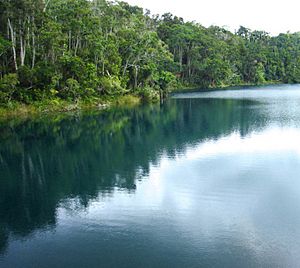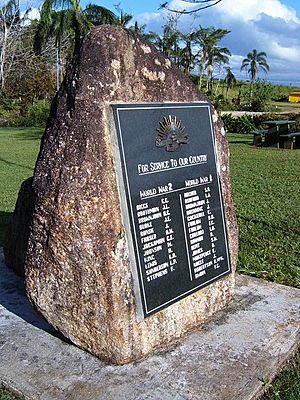Lake Eacham facts for kids
Quick facts for kids Lake Eacham(Yidyam or Wiinggina) |
|
|---|---|

View of Lake and Lake's edge from a Queensland National Parks viewing platform.
|
|
| Location | Atherton Tableland, Queensland |
| Coordinates | 17°17′08″S 145°37′30″E / 17.2855°S 145.625°E |
| Type | Crater lake |
| Basin countries | Australia |
| Average depth | 65.5 m (215 ft) |
Lake Eacham (also known as Yidyam or Wiinggina) is a beautiful lake in Queensland, Australia. It's located on the Atherton Tableland and was formed by a volcano. This special lake is part of the Wet Tropics of Queensland, which is a World Heritage site. It's a popular spot for families and tourists to enjoy nature and outdoor activities.
Contents
How Lake Eacham Was Formed
Lake Eacham (Yidyam) and nearby Lake Barrine were created about 12,000 years ago. This happened because of powerful volcanic activity. Hot, melted rock called magma rose from deep inside the earth. This magma heated the underground water. The boiling water turned into steam, which got trapped below the surface.
Eventually, huge explosions happened, releasing the steam. These blasts created massive cracks in the ground. Trees that once covered the mountainside were knocked down and burned. Over hundreds of years, water filled these large craters. New trees grew back, forming the peaceful lake we see today.
No streams flow into or out of Lake Eacham. Water is only lost through soaking into the ground or evaporating into the air. The lake is refilled by rainfall. Because of this, the water level can change a lot, sometimes by up to 4 meters between the wet and dry seasons.
The Aboriginal Story of Creation
The local Aboriginal people, the Ngadjon-jii, have their own story about how the lake was formed. They call the lake Wiinggina. Their story is very old and has been passed down through generations.
Here's a part of their story:
"Two young fellas were trying to spear that wallaby. But they missed and hit a flame tree. That’s a sacred tree. The young fellas not supposed to be out hunting. They weren’t initiated. Their elders told them to stay put, not go out hunting. But they didn’t listen. When they pulled their spear out, part of a grub came out with the spear, which was a witchetty grub. They started cutting down that tree to get more grubs. When they cut down that tree, the ground began to shake. Those two fellas had made Yamini (rainbow serpent) angry. Then the sky turned orange, then all these people back at the camp, the earth went from underneath them, sucked them in, whoosh, they all got drowned. Where they were camped became Bana Wiingina (Lake Eacham)." (Warren Cannendo, Ngadjon-Jii)
This story is part of an ancient oral history. Many believe it's a way the Ngadjon-jii people remember the volcanic events that happened 12,000 years ago. This makes it one of the oldest oral records in the world!
Lake Eacham's Recent History
In 1886, people first planned to divide the land around Lake Eacham (Yidyam) into farms. However, by 1888, everyone realized how beautiful the lake was. So, the lake and a small area of rainforest around it were officially made a "scenic reserve." This meant the area was protected for its beauty.
For nearly 50 years (from 1888 to 1936), the lake was used for fun activities. People enjoyed boating, and there was even a guest house, speed boats, and waterskiing. Then, in 1934, the Queensland Government decided to give the lake even more protection. They declared it a National Park. This helps make sure the lake and its surroundings are kept safe for future generations.
There is also a war memorial located in Yungaburra, which is a town near Lake Tinnaroo.
A Special Ecosystem and a Fish's Journey
Lake Eacham (Yidyam) is a "closed ecosystem." This means it's not connected to any other rivers or streams. So, how did fish get there in the first place? It's a bit of a mystery!
One special fish, the Lake Eacham rainbowfish (Melanotaenia eachamensis), somehow found its way into the lake. But then, other larger fish were brought into the lake by people. These new fish ate the small rainbowfish, and sadly, the Lake Eacham rainbowfish disappeared from the lake entirely. It was thought to be extinct there.
Luckily, some people who loved keeping fish (called aquarists) had collected these rainbowfish from the lake before they vanished. They had been breeding them successfully in their private collections. These fish became the source to bring the rainbowfish back to Lake Eacham!
However, the larger fish that caused the problem were still in the lake. They started eating the reintroduced rainbowfish again. But don't worry! Fish scientists (called ichthyologists) later found the Lake Eacham rainbowfish living in other rivers nearby, like the Tully, Herbert, and Johnstone Rivers, and Dirran Creek.
Besides the rainbowfish, Lake Eacham has two other native fish species: the gudgeon Mogurnda adspersa and the hardyhead Craterocephalus stercusmuscarum. Any other fish you might see in the lake were introduced by humans and are not native to the area.
Protected Area Status
Lake Eacham (Yidyam) is the main part of the 4.89 square kilometer (about 1,210 acres) Crater Lakes National Park. This park is home to dense rainforest and thousands of small animals. Because it's a National Park, it's a protected area under Queensland law. This means the lake and its natural and cultural features are looked after by the Queensland National Parks and Wildlife Service.
The lake is about 65.5 meters (215 feet) deep on average. Locals think it's a great place for swimming, canoeing, bushwalking, and bird watching. To keep the lake peaceful and clean, motor boats are not allowed.
There's a cool pontoon that's perfect for diving into the deep water. A large grassy area is available for picnics and playing. You can also enjoy a walk around the lake, which takes about 45 minutes to complete. If you look closely near the pontoon, you might even spot some turtles swimming!



